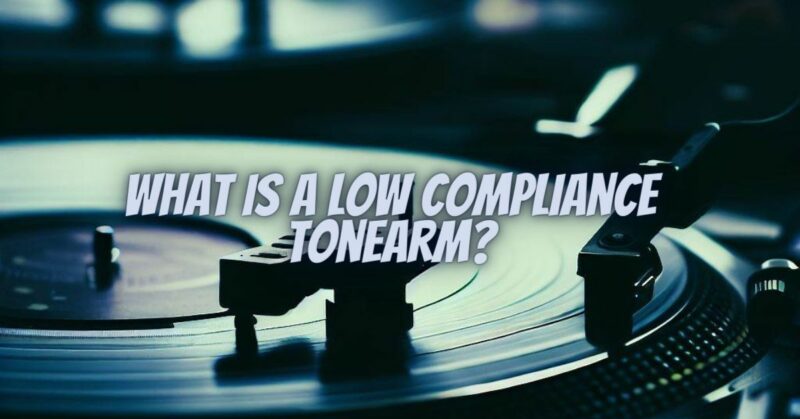A low compliance tonearm is a type of tonearm that has a stiff suspension. The compliance of a tonearm is a measure of how easily the tonearm can move in response to the grooves of a record. Low compliance tonearms are typically rated at 12 x 10⁻⁶ cm/dyne or below.
Advantages of using a low compliance tonearm
- Better tracking accuracy: Low compliance tonearms are better at tracking the grooves of a record accurately. This is because they have a stiffer suspension, which makes them less susceptible to vibration.
Tracking accuracy is the ability of the stylus to follow the grooves of the record accurately. It is important for tracking accuracy to be good in order to achieve the best possible sound quality.
Tracking accuracy can be affected by a number of factors, including the turntable platter, the turntable tonearm, the turntable cartridge, and the quality of the record.
A low compliance tonearm can help to improve tracking accuracy by reducing vibration. Vibration can cause the stylus to skip or mistrack, resulting in distortion and other sound problems.
- Improved sound quality: Low compliance tonearms can produce better sound quality than high compliance tonearms. This is because they are less likely to cause resonances in the audible range.
Resonance is the tendency of an object to vibrate at a certain frequency. A low compliance tonearm is less likely to resonate because it has a stiffer suspension.
Resonance can cause a number of problems with sound quality, including distortion, feedback, and a loss of detail. A low compliance tonearm can help to improve sound quality by reducing resonance.
- Reduced feedback from the speakers: Low compliance tonearms are less likely to cause feedback from the speakers. This is because they are less susceptible to vibration.
Feedback is a type of distortion that can occur when a turntable is not properly isolated from the speakers. Vibration from the speakers can cause the stylus to vibrate, which can lead to feedback.
A low compliance tonearm can help to reduce feedback by reducing vibration.
Disadvantages of using a low compliance tonearm
- More difficult to set up and adjust properly: Low compliance tonearms can be more difficult to set up and adjust properly than high compliance tonearms. This is because they are more sensitive to small changes in alignment and tracking force.
Tracking force is the amount of downward pressure that the stylus applies to the record. It is important to set the tracking force correctly in order to achieve the best possible sound quality.
A low compliance tonearm requires a higher tracking force than a high compliance tonearm. This is because a low compliance tonearm needs more force to move the stylus in response to the grooves of the record.
- Requires a low compliance cartridge: Low compliance tonearms require a low compliance cartridge in order to function properly. A low compliance cartridge is a cartridge that has a stiff suspension, which allows it to resist the force of the tonearm.
Compliance matching is important when choosing a tonearm and cartridge. The compliance of the tonearm and cartridge should be matched in order to achieve the best possible sound quality.
If the tonearm and cartridge are not matched, it can lead to tracking problems and other sound quality issues.
Which type of tonearm is right for you?
The best type of tonearm for you depends on your personal preferences and your vinyl collection. If you are serious about vinyl playback and you have a high-quality vinyl collection, then a low compliance tonearm may be the best choice for you. However, if you are new to vinyl playback or you have a more modest vinyl collection, then a medium mass or high mass tonearm may be a better choice.
Here are some additional things to consider when choosing between a low compliance tonearm and a higher compliance tonearm:
- The type of music you listen to: If you listen to music with a lot of bass or dynamic range, then a low compliance tonearm may be a better choice for you. This is because low compliance tonearms are better at tracking the grooves of a record accurately and reducing feedback from the speakers.
- Your budget: Low compliance tonearms are typically more expensive than high compliance tonearms. This is because they require more precise manufacturing and engineering.
- Your listening habits: If you listen to your music at high volume levels, then a low compliance tonearm may be a better choice for you. This is because low compliance tonearms are more resistant to vibration.
Ultimately, the best way to decide which type of tonearm is right for you is to listen to different turntables with different tonearms and see which one sounds best to you. You can also consult with an audiophile expert to get their recommendations.


